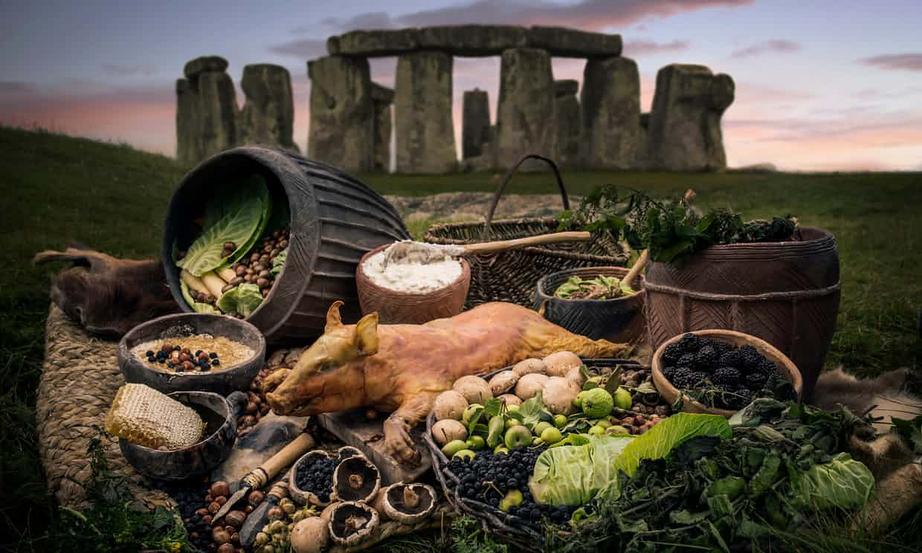What did neolithic man eat after a hard day at Stonehenge? Sweet pork and rich cheese
Britons’ Stone Age ancestors possessed some unexpected talents, scientists have discovered. On top of their prowess in constructing great monoliths such as Stonehenge, they were also adept at staging first-rate parties.
Roast sweetened pork consumed with a range of rich dairy products including cheese and butter appear to have been commonplace at feasts – according to an English Heritage exhibition, Feeding Stonehenge, which will open this week at the stone circle’s visitor centre.
“More than 4,500 years have passed since the main part of Stonehenge was constructed,” said curator Susan Greaney. “But thanks to the sophistication of techniques we now have for dating and identifying chemicals, we can deduce – from food fragments left in pots and from the bones left in the ground – what meals were being consumed there.”
Stonehenge was constructed in several stages. However, the most important period occurred around 2,500BC when the great sarsen blocks that form the main ring were erected, said Greaney. “Recent analysis suggests this construction was completed over a period of about 50 years,” she added.
Scientists have also dated the occupancy of the neolithic village of Durrington Walls – which lies about a mile and a half north-east of Stonehenge – to a 50-year period that also occurred around 2,500BC.
“From this, we have drawn the conclusion that Durrington Walls was the place where the builders of Stonehenge lived and where they held celebrations connected with the great edifice they were building,” said Greaney.
The question is: what sustained these workers during the titanic task they had undertaken? What foods did they consume? “When we dug at Durrington Walls we found pits and middens filled with bits of pottery and bones of animals left over from feasts,” said Stonehenge researcher Professor Oliver Craig, of York University. “These have provided an immense amount of information.”
From the pot fragments, scientists were able to pinpoint fats, waxes and oils from the food cooked in these vessels. These fats, which seeped into the pottery and collected in pores, can now be analysed by a technique known as lipid analysis.
“We found the larger pots contained mainly pork,” said Craig. “However, smaller pots – which were found at different parts of the Durrington Walls site – contained dairy products. We think these milk-based foodstuffs had special significance. They may have been associated with purity or fertility, for example, and were consumed in a special area.”
The presence of dairy food poses a puzzle, however. Genetic evidence indicates that Britons at this time were lactose intolerant. Drinking milk would have made them ill. Yet dairy foods appear to have had widespread use.
This has led Craig and other scientists to argue that cow’s milk would not have been consumed directly but would have been turned into cheese and yoghurt – which would not have triggered lactose intolerance reactions. In other words, people gathering for these festivals would have been eating protein-rich dishes of butter and cheese and other processed dairy products.
As to the meat that was consumed, by far the most popular animal was the pig. “There are bits of pig skeleton, dated from this period, all over the place,” said Greaney. “And when you look at the teeth of these animals, it is noticeable that there are strong signs of decay – which suggests they were being fattened up on fairly sweet diets, possibly using honey. So honey-sweetened pork could well have been on the menu at these feasts.”
All the signs point to the fact that Stonehenge and Durrington Walls were associated with some very lavish celebrations. For example, at most other archaeological sites where animal bones have been left behind after being eaten, very little is left unconsumed. This was not the case at Durrington Walls where half-eaten chops were left discarded in many places. “This could have been the country’s first throw-away culture,” said Greaney.
This point was backed by Craig. “People were killing animals, stringing them up and eating them on a massive scale,” he said. “It must have been quite a show.”
However, this high protein intake of meat and cheeses was probably not typical of average Stone Age meals, he added. “I think people in those days would also have been eating vegetables and fruit but not here. Pork and beef and cheese – that was special festive fare – and that is what was consumed at Stonehenge.”
But the identity of any beverages that were consumed remains a mystery. “People always ask me: were our forebears consuming wine or beer or some other kind of alcoholic drink?” said Craig. “The answer is that we do not know. They may well have been, but we do not have the techniques or the evidence yet to say what that drink might be. That is for future research.”

